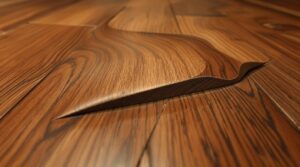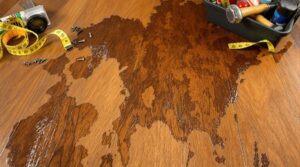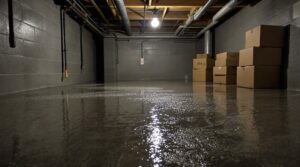Homeowners insurance generally covers water damage to floors when caused by sudden, accidental events like burst pipes, appliance malfunctions, or wind-driven rain through roof damage. Standard policies include coverage for emergency drying, professional restoration services, and necessary repairs. However, damage from flooding, groundwater seepage, or maintenance neglect is typically excluded. Policy specifics and incident classification determine coverage terms, while proper documentation and prompt reporting maximize claim success. Understanding additional coverage options guarantees thorough floor protection.
Key Takeaways
- Standard homeowners insurance covers sudden and accidental water damage to floors from burst pipes, appliance leaks, and wind-driven rain.
- Water damage from poor maintenance, gradual deterioration, or long-term leaks is typically not covered by homeowners insurance.
- Flood damage, groundwater seepage, and sewer backups require separate insurance coverage or additional endorsements.
- Coverage includes emergency drying, professional restoration services, and repairs when damage results from covered incidents.
- Insurance claims require immediate action, thorough documentation with photos, and professional assessments to ensure maximum coverage.
Understanding Water Damage Coverage in Home Insurance
When homeowners evaluate their insurance coverage, understanding water damage provisions is essential since not all types of water-related incidents are protected under standard policies. The coverage implications vary greatly based on the source and nature of the damage.
Standard homeowners insurance typically covers sudden and accidental water damage, such as burst pipes, unexpected appliance leaks, and toilet overflows caused by blockages. Wind-driven rain entering through roof damage and ice dam-related issues are also generally included in basic coverage.
However, several water-related incidents fall outside standard protection. These exclusions commonly include flood damage, groundwater seepage, and sewer backups.
Additionally, damage stemming from poor maintenance or gradual deterioration, such as continuous leaks or resulting mold growth, typically lacks coverage. The determination of coverage depends on policy type, specific language, and whether the incident qualifies as sudden and accidental versus gradual damage.
Common Types of Floor Damage Covered by Insurance
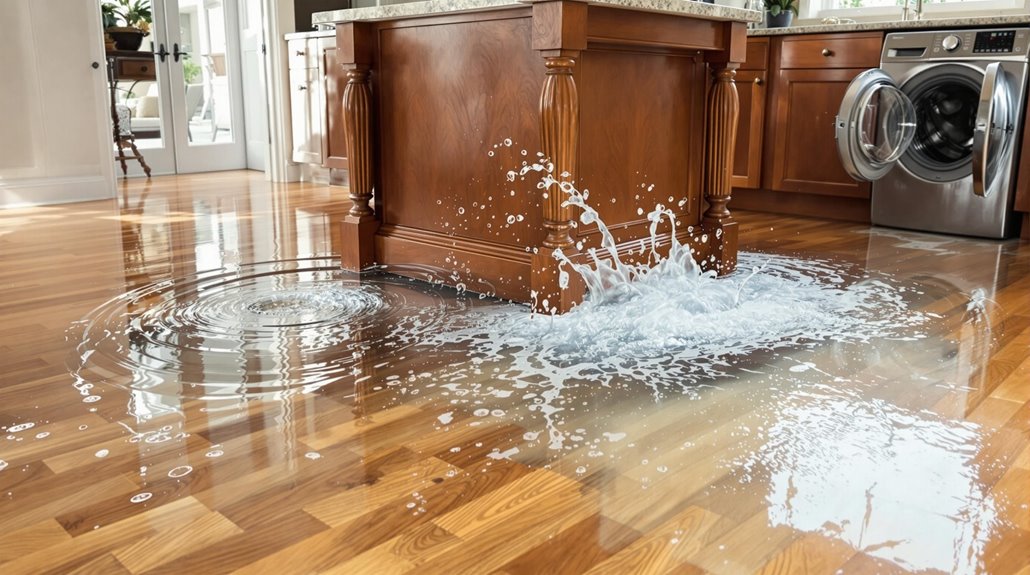
Insurance policies typically provide coverage for sudden and unexpected floor damage caused by burst pipes, which can lead to extensive water infiltration and material deterioration.
Coverage extends to incidents involving appliance malfunctions, such as washing machine overflows or dishwasher leaks that result in water saturation of flooring materials.
These water-related incidents are generally covered under standard homeowner's insurance policies, provided the damage occurs from a sudden event rather than long-term exposure or gradual deterioration.
Sudden Pipe Burst Damage
Most sudden pipe burst incidents cause extensive floor damage that standard homeowners insurance policies typically cover under dwelling coverage.
When water damage originates from inside the home due to burst pipes, insurance providers generally approve claims for repairs or replacement of affected flooring materials, including hardwood, laminate, and subflooring.
Insurance coverage extends to emergency drying procedures and professional restoration services to mitigate further damage.
Leak detection services and necessary plumbing repairs are also typically included in the coverage.
However, coverage may be denied if the damage results from long-term leaks exceeding 14 days or shows evidence of neglect.
Insurance companies often recommend qualified water damage restoration contractors to guarantee proper drying and repair processes, particularly for sensitive materials like hardwood floors.
Appliance Overflow Issues
Sudden appliance malfunctions leading to water overflow represent a significant category of floor damage covered under standard homeowners insurance policies. Common incidents include washing machine overflows, dishwasher leaks, water heater failures, and refrigerator water dispenser malfunctions.
These events typically fall under dwelling coverage for structural damage and personal property coverage for affected contents.
For successful claims, immediate documentation and prompt reporting to insurance providers are essential. However, coverage excludes damage from gradual leaks or poor maintenance.
Implementing effective appliance maintenance tips, such as regular inspections and timely repairs, is vital for water damage prevention. Installing water alarms and monitoring appliance connections can help detect issues early, potentially preventing extensive floor damage and costly insurance claims.
Steps to File a Water Damage Claim
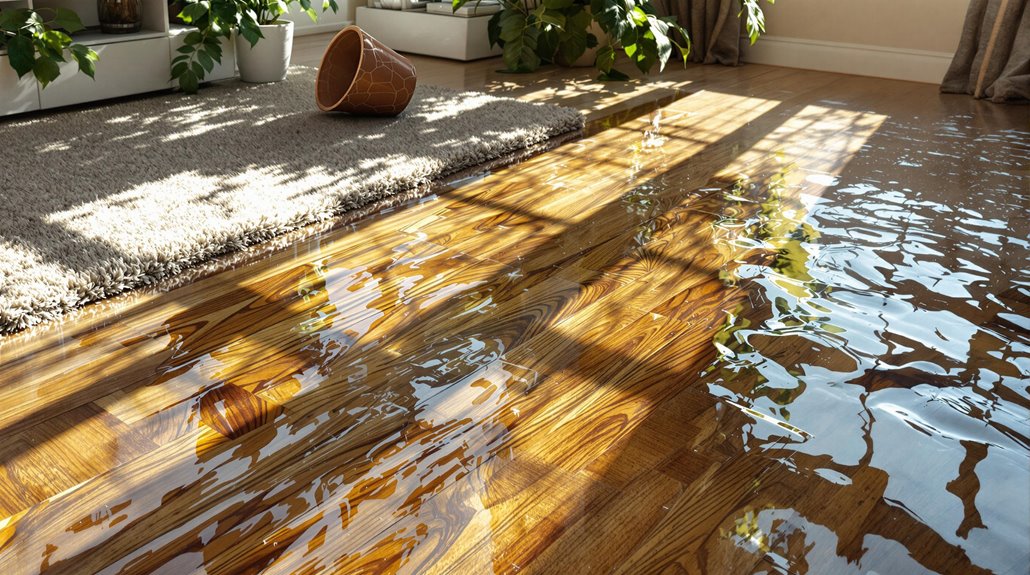
Filing a successful water damage claim requires homeowners to follow several critical steps that begin immediately after discovering the damage.
The initial priority involves locating and stopping the water source, whether it's a burst pipe or malfunctioning appliance, to prevent further destruction. Homeowners must then thoroughly document the damage through photographs and videos while preserving any relevant physical evidence.
Once documentation is complete, homeowners should promptly contact their insurance provider to initiate the claim process. This includes reviewing policy coverage details to understand what types of water damage are covered and any applicable exclusions.
The insurance company will typically dispatch an adjuster to assess the damage and determine settlement options. Throughout this process, homeowners should maintain detailed records, obtain professional cleanup services if necessary, and be prepared to negotiate the settlement based on contractor estimates.
Swift action and proper documentation greatly influence the success of water damage claims.
When Insurance Won't Cover Floor Water Damage
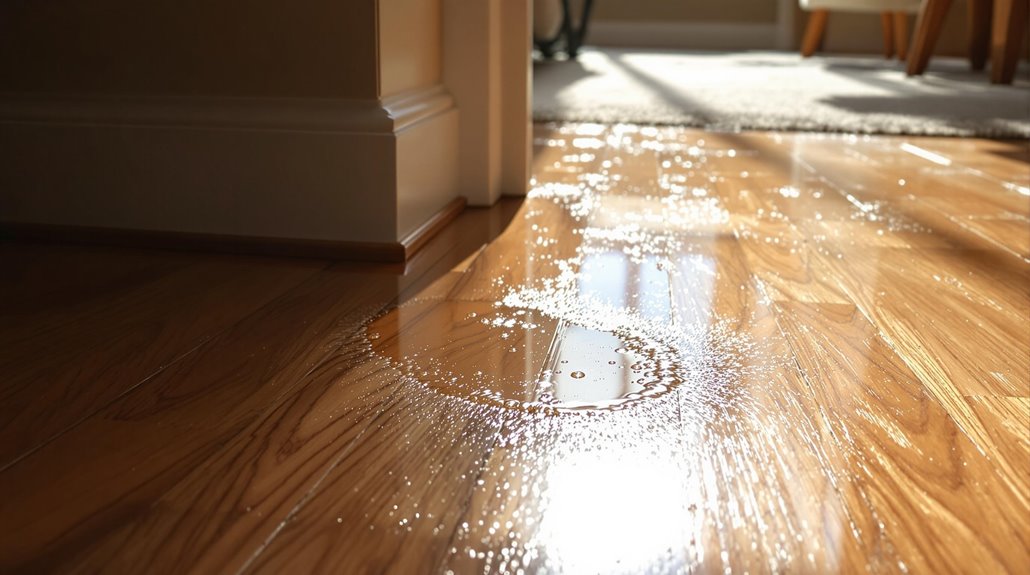
While homeowners can take proper steps to file water damage claims, understanding when insurance won’t cover floor water damage is equally significant. Insurance policies contain specific water damage exclusions that deny coverage for groundwater seepage, flooding, and sewer backups. Standard policies also exclude damage resulting from poor maintenance or gradual deterioration of plumbing systems. Homeowners must also be aware that insurance coverage for water damage may vary significantly between policies, making it essential to thoroughly review the terms and conditions. For instance, some policies might require additional endorsements to cover certain types of water damage that are typically excluded. To avoid unexpected out-of-pocket expenses, it’s crucial to engage with an insurance agent to clarify any uncertainties about what is or isn’t included in your coverage.
| Type of Water Damage | Coverage Status | Required Action |
|---|---|---|
| Flooding/Rising Water | Not Covered | Purchase Flood Insurance |
| Sewer Backup | Not Covered | Add Special Endorsement |
| Maintenance Issues | Not Covered | Regular Maintenance |
Insurance policy nuances dictate that water damage must be sudden and accidental for coverage to apply. Any damage from water that contacts the ground before entering the home is typically excluded. Additionally, water entering through foundation walls or external sources falls outside standard coverage parameters. Understanding these exclusions helps homeowners make informed decisions about supplemental coverage needs and maintenance responsibilities.
Preventing Water Damage to Your Floors
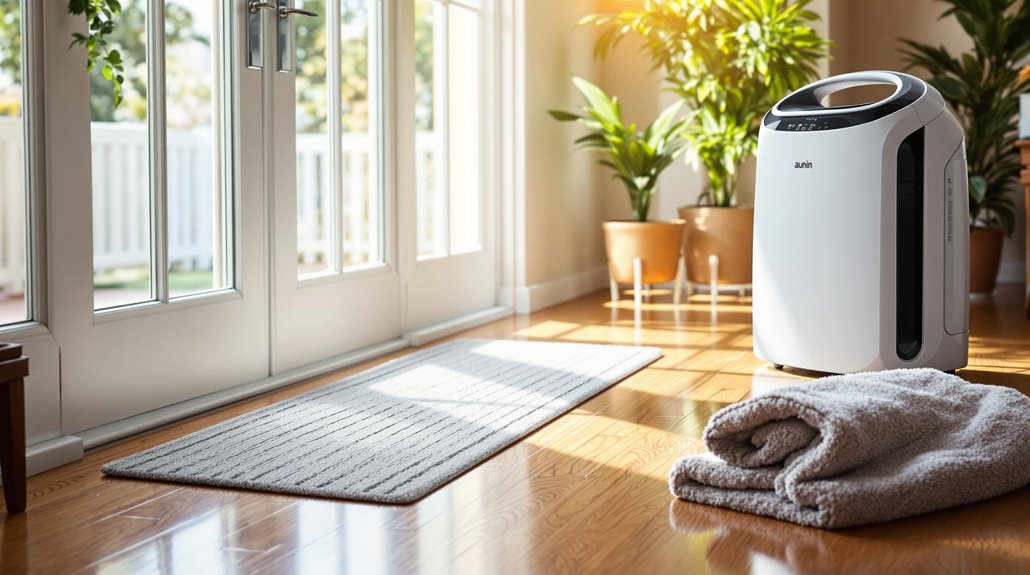
Protecting floors from water damage requires a thorough preventive maintenance strategy that encompasses regular inspections, proper sealing, and swift response protocols.
Essential water leak prevention measures include monitoring pipes, taps, and appliances for potential leaks while maintaining proper humidity levels through dehumidifier usage when necessary.
Effective floor maintenance tips focus on applying protective finishes such as polyurethane, lacquer, or varnish to create water-resistant barriers.
Strategic placement of absorbent mats near water-prone areas like bathrooms, kitchens, and entrances helps minimize risk.
When cleaning, using slightly damp mops rather than oversaturated ones prevents excessive moisture exposure.
Implementing immediate response protocols for water spills is vital. This includes rapid deployment of dense towels for absorption, removal of wet objects, and utilization of water vacuums for standing water removal.
Creating proper ventilation accelerates the drying process, while regular inspections help identify and address potential issues before they escalate into significant damage.
Documenting Floor Damage for Insurance Claims
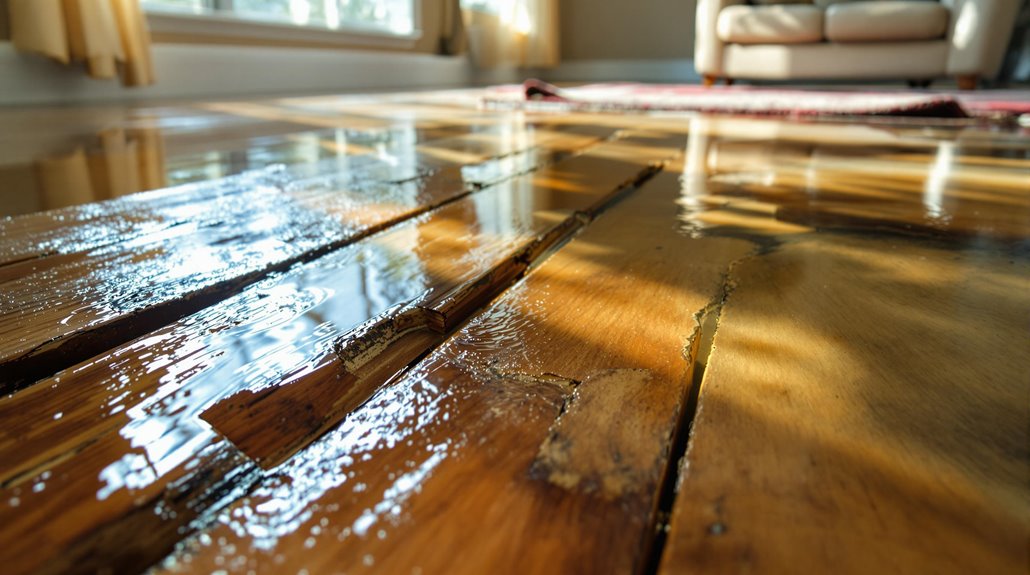
Once water damage occurs, proper documentation becomes the foundation of a successful insurance claim process. Homeowners should immediately begin documenting damage through extensive photo and video evidence, capturing both close-up details and wider room perspectives. All visual documentation should include date and time stamps to establish a clear timeline of events.
Evidence collection should include samples of damaged flooring materials, properly labeled with location and date information. Maintaining detailed records of all related expenses, including repair estimates and replacement costs, strengthens the claim.
Professional assessments from independent appraisers or flooring experts provide essential third-party verification of damage extent and repair requirements. For maximum claim effectiveness, homeowners should promptly notify their insurance provider and maintain systematic records of all communications.
Working with an insurance claims lawyer can guarantee proper documentation procedures are followed, while consulting with flooring specialists helps establish accurate repair cost estimates. This thorough approach to documentation supports a more efficient claims process and improved likelihood of appropriate compensation.
Insurance Coverage Limits and Deductibles
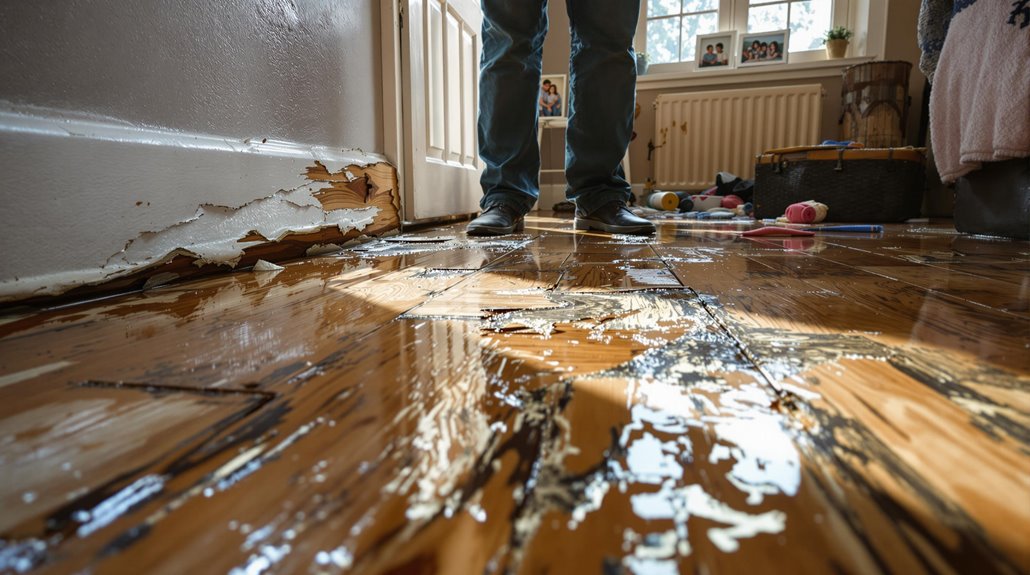
Insurance coverage limits and deductibles establish the financial framework for water damage claims in homeowners insurance policies. When evaluating coverage comparisons, homeowners must understand that standard policies include both dwelling coverage for structural repairs and personal property coverage for damaged belongings. The deductible implications vary by policy and directly affect out-of-pocket expenses before insurance coverage activates.
Key aspects of insurance coverage and deductibles for water damage:
- Policy-specific limits determine maximum payout amounts for both dwelling and personal property damage.
- Deductibles apply to each individual claim and influence premium costs.
- Higher deductibles typically result in lower premiums but increased claim expenses.
- Coverage excludes flood damage, requiring separate flood insurance policies.
Understanding these financial parameters is essential for homeowners, as coverage limits and deductibles greatly impact the cost of water damage repairs.
Policy exclusions for gradual leaks, neglect, and flooding further define the scope of available coverage for floor damage claims.
Additional Insurance Options for Water Protection
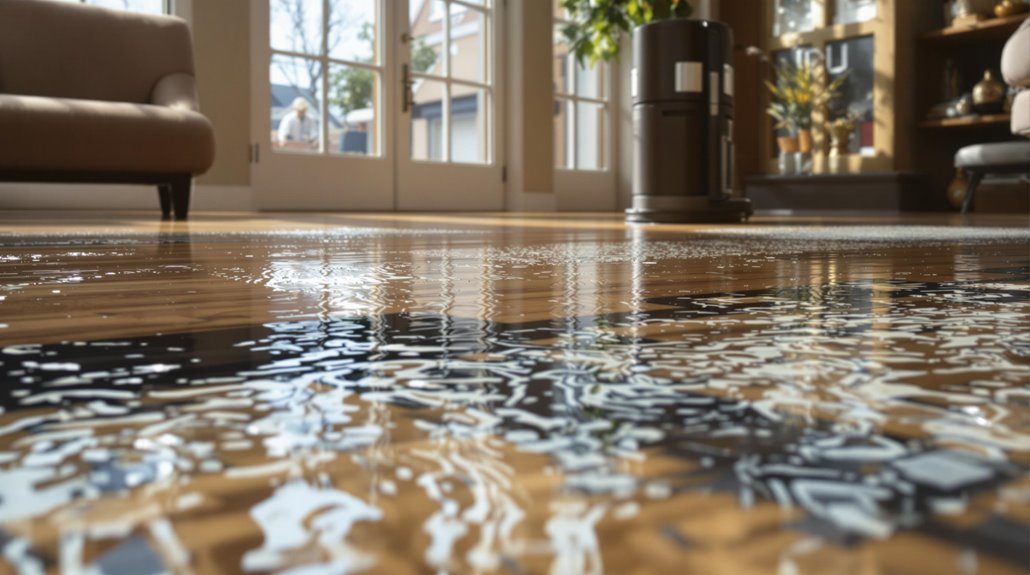
Beyond standard homeowners insurance coverage limits and deductibles, property owners should consider supplementary water protection options to address specific risks not covered by basic policies.
Water backup coverage, which typically costs between $50 and $250 annually, protects against damage from clogged sewer lines, failed sump pumps, and backed-up drains, with coverage limits ranging from $5,000 to full replacement cost.
Separate flood insurance policies are essential for protecting against damage from external water sources, such as heavy rainstorms or overflowing bodies of water. The cost varies based on location and risk factors.
Additional endorsements can include protection against sump pump overflow and resulting mold damage. These supplementary options are particularly important for older homes or properties in high-risk areas.
Since water damage ranks among the most common homeowners insurance claims, extensive protection through additional coverage options provides vital financial security against costly repairs.
The Benefits Of Consulting A Public Adjuster
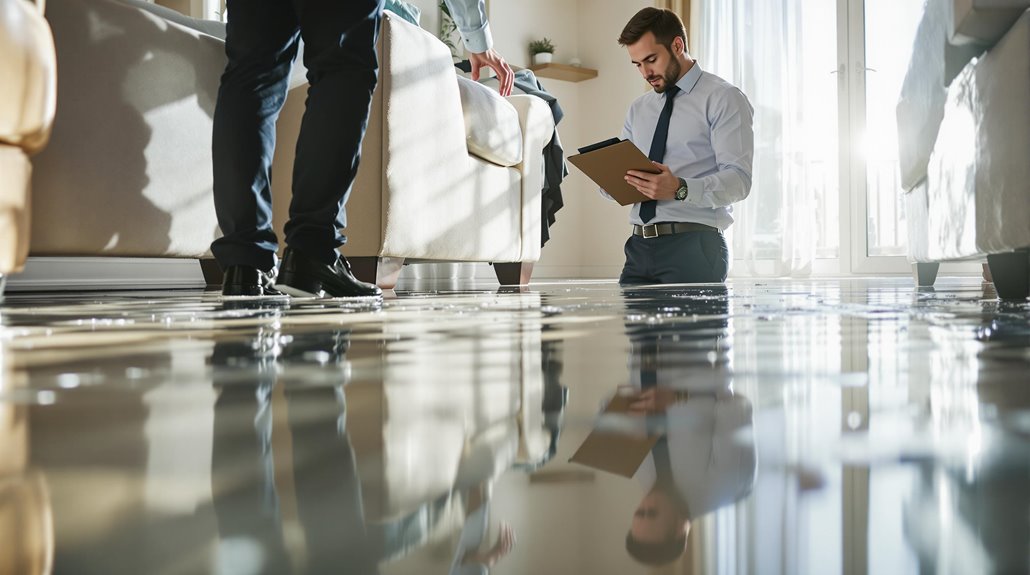
Public adjusters offer specialized expertise in guiding complex water damage insurance claims, providing objective assessments and documentation that insurance companies require for processing.
Their professional management of the claims process helps streamline communications, negotiations, and settlement procedures while removing emotional stress from affected homeowners.
Statistical evidence indicates that claims handled by public adjusters typically result in higher settlement amounts, with studies showing average payouts approximately 20% greater than claims filed without professional assistance.
Expertise In Insurance Claims
When dealing with complex water damage claims, consulting a public adjuster provides homeowners with specialized expertise that can greatly impact claim outcomes.
Public adjusters possess thorough insurance policy analysis skills and demonstrate claims process efficiency through their deep understanding of coverage terms, exclusions, and regulatory requirements. Their expertise enables accurate interpretation of policy language and maximizes potential benefits for the policyholder.
- Expert evaluation of policy coverage and limitations specific to water damage scenarios
- Professional documentation management ensuring complete and accurate claim submissions
- Strategic negotiation capabilities based on extensive industry knowledge
- Thorough understanding of local insurance regulations and compliance requirements
This specialized knowledge allows public adjusters to navigate complex claims systematically while ensuring all aspects of water damage to floors are properly assessed and documented for ideal settlement outcomes.
Objective Damage Assessment
Professional objective damage assessment stands as a cornerstone benefit of engaging a public adjuster for water damage claims. Through extensive damage evaluation techniques and specialized tools like moisture meters and thermal imaging, public adjusters uncover both visible and concealed structural issues. Their expertise in claim documentation guarantees thorough evidence collection through photos, videos, and detailed descriptions.
| Assessment Component | Benefits Delivered |
|---|---|
| Moisture Detection | Identifies hidden water damage and potential mold growth |
| Structural Analysis | Evaluates integrity of floors and supporting elements |
| Documentation Methods | Creates extensive evidence package for claims |
This systematic approach, combined with their knowledge of insurance policies and state regulations, enables public adjusters to secure maximum compensation for water-damaged floors while effectively countering insurance company minimization tactics.
Streamlined Claim Process
Understanding how to navigate the complexities of water damage claims, homeowners increasingly turn to public adjusters for their proven ability to streamline the insurance process.
Advanced claim automation technologies and positive customer feedback demonstrate that professional assistance markedly reduces processing time while guaranteeing thorough coverage.
Public adjusters leverage digital solutions to expedite claims from FNOL to settlement, potentially reducing the traditional 15-day timeline to just hours.
- Documentation management through digital platforms enables swift claim submission and assessment
- Remote damage evaluation using photos and videos eliminates delays from on-site inspections
- Automated triage systems facilitate immediate adjuster assignment and claim categorization
- Professional expertise guarantees accurate damage assessment and maximum policy coverage while maintaining clear communication channels between all parties
Higher Claim Payouts & Settlements
While homeowners might attempt to handle water damage claims independently, consulting a public adjuster greatly increases the likelihood of securing higher settlements.
Public adjusters employ proven claim strategies through their expertise in policy interpretation, thorough damage assessment, and skilled negotiation with insurance companies.
Their extensive evaluation process guarantees all water-related damages are properly documented and included in the claim submission.
Through detailed assessment and understanding of policy provisions, adjusters implement payout maximization techniques that many homeowners might overlook.
Operating on a contingency fee basis, these professionals are incentivized to secure the highest possible settlement.
Their expertise not only relieves homeowners of the complex claims process but also typically results in settlements that justify their service fees while enabling property owners to focus on restoration efforts.
About The Public Claims Adjusters Network (PCAN)

The Public Claims Adjusters Network (PCAN) serves as a nationwide alliance of licensed public insurance adjusters who advocate for policyholders during the claims process.
When dealing with water damage to floors, these professionals help navigate complex insurance policies and guarantee fair claim settlements. Public adjusters within the network specialize in documenting damage, interpreting policy language, and negotiating with insurance companies on behalf of homeowners.
- PCAN members provide expert claim assistance for various types of water damage, including sudden pipe bursts, appliance failures, and roof leaks.
- Adjusters help differentiate between covered perils and excluded events like flooding or gradual leaks.
- Network professionals assist in documenting emergency drying procedures and necessary floor repairs.
- Members advocate for maximum coverage within policy limits while guaranteeing proper damage assessment.
PCAN's expertise becomes particularly valuable when dealing with extensive floor damage, as adjusters understand the nuances between different flooring materials and their replacement costs under insurance policies.
Frequently Asked Questions
Can I Choose a Different Flooring Material When Insurance Covers Replacement?
Insurance policies typically allow different flooring options, but coverage only extends to materials of equal or lesser value than the original. Homeowners must pay additional costs for upgraded materials.
How Long Does Water Damage Claim Processing Typically Take?
Water damage timeline typically spans 4-8 weeks from initial claim to payment, depending on claim approval factors like damage complexity, documentation completeness, cause determination, and current adjuster workload.
Will Insurance Cover Temporary Housing During Floor Repairs?
While homeowners dream of endless hotel stays, insurance coverage for temporary housing depends strictly on policy specifics, requiring sudden, accidental damage and clear documentation of uninhabitable living conditions.
Does Insurance Cover Mold Remediation if Discovered During Floor Repairs?
Insurance typically covers mold remediation costs when discovered during repairs if caused by a covered peril. Standard policies include basic mold coverage with specific limits between $1,000-$10,000 for qualified scenarios.
Can Previous Water Damage Claims Affect My Future Insurance Rates?
Like ripples in a pond, previous water damage claims cascade into future premium increases, as insurers evaluate claim history to determine risk levels and adjust rates accordingly.

